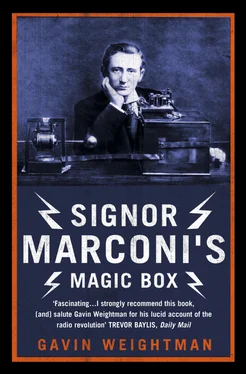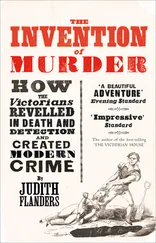After the triumph of his Channel transmissions, Marconi’s equipment was given a trial by the British Admiralty during naval manoeuvres in the summer of 1899, when the only rival method of long-distance communication was the carrier pigeon. At the same time the huge publicity afforded his experiments attracted the attention of the New York Herald’ s flamboyant owner Gordon Bennett Jr, son of the famous newspaper proprietor of the same name who had built a reputation on being first with the news. Marconi, still surviving on the investment funds of his City backers and with precious little income, accepted an offer to cover for the Herald the America’s Cup yacht races, first held in 1851, which would take place in October 1899. When he set out for New York on the Cunard Line’s Aurania in September it was his first experience of the romance of the Atlantic liners which were to play such an important part in his life.
*There is an error in the original: this should read ‘640 miles’.
In 1899 the night-time spectacle of New York as the great liners were steered on taut hawsers towards their moorings was breathtaking. The Statue of Liberty was floodlit, and the Brooklyn Bridge a blaze of light. While many homes were still lit by gas, the electricity which illuminated public buildings and stores had in just a decade or so turned New York into a dazzling wonder of the modern world. If Guglielmo Marconi was to find real rivals in the exploitation of his new invention it would surely be here, in a land apparently obsessed with electrical power. And yet he was greeted like a conquering hero by American newspapermen when the Auratiia docked in New York on 21 September. They all wanted to know who this young man was, and were struck by how much he differed from the inventive genius of their lively imaginations. In a report Marconi gave to the Wireless Telegraph and Signal Company back in London he wrote that he had to ‘run the gauntlet’ of reporters and photographers as soon as he went down the gangway. ‘For some reason or other it seemed to come as a shock to the newspapers that I spoke English fluently, in fact “with quite a London accent” as one paper phrased it, and also that I appeared to be very young and did not in the slightest resemble the popular type associated with an inventor in those days in America, that is to say a rather wild haired and eccentrically costumed person.’ He did however for a while lose his legendary cool: half his luggage had by mistake been diverted to Boston. In its report of 22 September 1899 the New York Tribune , which noted that Marconi explained about his missing luggage in ‘good English’, commented: ‘He is a slight young man of light complexion and nervous temperament, and he is a bit absent-minded. He is evidently more concerned about his scientific studies and inventions than about conventionalities and dress. He has clear blue eyes, and his face is clean shaven, except for a small moustache.’ The Tribune man had clearly caught Marconi off his guard: it was rare for him to be described as anything but well dressed when he made his public appearances.
No sooner had Marconi and his engineers begun to establish a shore station for the coverage of the America’s Cup than his extraordinary celebrity was eclipsed by the return from the Far East of a real American conquering hero. In 1898 the United States had gone to war with Spain. Cuba was then still a Spanish colony, but was being torn apart by a nationalist rebellion which America supported. The United States also coveted the Spanish colonies in the Philippines. When the American battleship Maine was blown up in Havana harbour the Spanish were ordered out of Cuba. Under the command of Admiral George Dewey, the American fleet had taken on the Spanish in the Philippines, and at the battle of Manila routed them without losing a single life. In September 1899 Admiral Dewey was on his way back to New York, where he would receive a tumultuous reception. The America’s Cup was delayed a few days so that the Governor of New York State, Theodore Roosevelt, could stage the most spectacular ‘welcome home’ ever witnessed in the United States.
When Dewey and his fleet steamed into New York the Brooklyn Bridge blazed ‘WELCOME DEWEY’ in lightbulb letters thirty-six feet high and 370 feet across. One thousand bulbs were used for the letter ‘W’ alone. On Manhattan a victory parade a mile and a half long was lined with wood and plaster statues leading to a Dewey Arch. A two-day holiday was declared, and fireworks cracked in the bright electric air for several nights. Not wanting to be upstaged, the New York Herald asked Marconi to throw his wireless equipment on a tug and go out to greet Dewey before he docked. Back in the 1830s James Gordon Bennett Sr had made his name by beating rivals to the European stories arriving on Atlantic ships. As the sailing packets and later the steam liners approached Staten Island, despatch boats were sent out to collect the news and carry it to the New York Herald office so that it could be published before the ships docked. Gordon Bennett Jr was the man who sent Henry Stanley to seek out Dr Livingstone in Africa, and Stanley’s celebrated formal greeting, ‘Dr Livingstone, I presume,’ had entered the language. He was also the promoter of a company which was involved in laying the first telegraph cables across the Atlantic. Though the younger Bennett now spent most of his time on his lavish yacht in the Mediterranean, the Herald had not lost its competitive edge.
Admiral Dewey arrived in New York two days earlier than expected, and Marconi missed the chance to waylay him at sea. However, the Herald was not to be defeated, and was able to arrange for Marconi to take part in a parade of ships held in Admiral Dewey’s honour. Shore stations had already been set up on the Navesink Highlands along the New Jersey shoreline and atop a building on 34th Street in New York in preparation for the America’s Cup coverage, and Marconi and his engineers set up their equipment on two steamships, the Ponce and the Grande Duchesse. While they were still working frantically to make contact with the shore stations, the Herald had the Ponce cruise past Admiral Dewey’s flagship, and reported the great cheers that went up when the crowds on both decks were told that Marconi, the wireless genius, was aboard. At one point, according to an ecstatic Herald account, a young woman on a ship in the harbour picked up a microphone and called ‘Three cheers for Marconi!’, to which there was a roared response. Marconi himself, however, stayed at his station, and made no public appearance until he was sure his wireless equipment was working, leaving the captain of the Ponce to make his excuses by megaphone.
The Herald gave its Marconi wireless coverage a fanfare on Sunday, 1 October 1899, with illustrations of the young Italian’s equipment and glowing reports of the way in which he had turned a scientist’s dream into an accomplished fact. As he followed the fortunes of the competing yachts, the fabulously wealthy English tea magnate Sir Thomas Lipton’s Shamrock and the New York Yacht Club’s Columbia , the news was tapped back to the shore stations on the Navesink Highlands and 34th Street. From there it was sent to Europe and across North America by cable. Marconi worked at first on the Ponce, attracting a crowd of passengers who, according to Herald reports, were more interested in the inventor than in the progress of the races. There were good commercial reasons for the Herald to hire Marconi’s wireless telegraphy system, apart from the interest it would attract and the newspapers it would sell. As customers of the various land-line telegraph services, newspapers were always haggling over the cost of using cables for messages. If wireless worked, it would be a serious, and cheaper, rival.
Читать дальше












